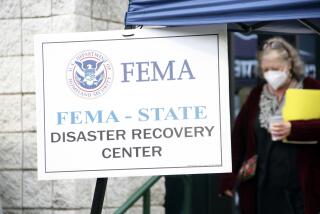An Orderly Storm Response This Time
- Share via
WASHINGTON — As Hurricane Wilma lashed Florida, federal authorities rushed water, communications equipment and emergency personnel into stricken areas with few signs of the tragic disorder that plagued the government response to Hurricane Katrina.
R. David Paulison, acting director of the Federal Emergency Management Agency, said the agency’s preparations included pre-positioning 300 satellite phones with agency workers in Florida to ensure that communications did not break down.
He said FEMA, using lessons learned from Katrina and taking advantage of the relatively long advance warning Wilma provided, was working closely with state officials to achieve what he called “total situation awareness” -- that is, to make sure everyone knew what was happening and what everyone else was doing.
Communication glitches and misunderstandings among government agencies contributed to the chaotic response to Katrina.
“It’s difficult so far to get a total picture of the damage,” Paulison said in a briefing Monday. “But we do have a lot of people on the ground, and people need to feel very secure down there that the state and FEMA are ready to respond with all those pre-positioned assets that we’ve been talking about.”
FEMA’s robust response to Wilma was aided by the fact that the agency has a permanent presence in Florida, where hurricanes are a fact of life. Since the National Weather Service began keeping records in 1851, seven of the nine major hurricanes that have hammered the U.S. during the month of October have struck Florida.
Florida has an infrastructure, leadership and a population used to coping with the battering storms and the damage they leave behind.
“It happens so frequently in Florida, people are a little more aware,” said Pleasant Mann, a FEMA program specialist in Washington.
Equally important, Wilma did not inflict the kind of devastation visited on the Gulf Coast by Katrina, a Category 4 storm when it made landfall that left 80% of New Orleans underwater.
“We knew that it would be more of what we’re used to dealing with than what we had with Katrina,” Mann said.
In the case of Wilma, FEMA got considerable advance warning, agency officials said. Katrina gave the Gulf Coast about 48 hours’ notice. Initial predictions for Wilma began about a week before landfall and were highly accurate, allowing FEMA to plot a strategy along with the hurricane’s route.
“We could look at the prediction, see where we could deploy stuff ahead of time,” Mann said. “If we needed new people, that gives you more time to move them into position.”
The Pentagon and FEMA deployed extra communications equipment, the Pentagon stationed emergency response planners at FEMA headquarters in Washington, and FEMA delivered increased amounts of food, water and ice to the region. The agency also pre-positioned natural disaster medical teams and urban search-and-rescue teams.
Fran Townsend, President Bush’s domestic security advisor, explained the extra measures over the weekend, saying that readiness procedures for Katrina “were all wrong” and that the federal government would be more ready to respond to state and local officials in Wilma’s aftermath.
Paulison said, “We’re prepared to handle this one.”
FEMA’s permanent presence in Florida actually had been established by the agency’s former director, Michael D. Brown, who was roundly criticized for the agency’s response to the Gulf Coast emergency.
Brown opened the Florida Long Term Recovery Office in Orlando after four hurricanes pummeled the state in 2004. It was given authority to deal with new disasters.
In addition, Floridians are well versed in storm preparations, and state officials are practiced in overseeing evacuations and other hurricane response matters. That familiarity may make for a crucial difference separating Florida’s response to Wilma from the Gulf Coast reaction to Katrina.
In Florida, Mann said, “there were lots of things we worried about that didn’t happen.” For instance, he said, “we asked whether gas stations on the major evacuation routes had enough gas, and they did. Everything went smoothly.”
*
Times staff writer Emma Vaughn contributed to this report.
More to Read
Sign up for Essential California
The most important California stories and recommendations in your inbox every morning.
You may occasionally receive promotional content from the Los Angeles Times.










